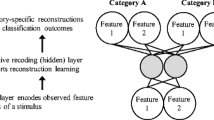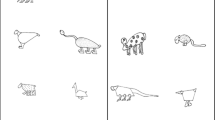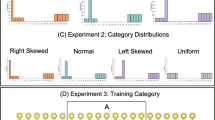Abstract
Classic studies of human categorization learning provided evidence that high-variability training in the prototype-distortion paradigm enhances subsequent generalization to novel test patterns from the learned categories. More recent work suggests, however, that when the number of training trials is equated across low-variability and high-variability training conditions, it is low-variability training that yields better generalization performance. Whereas the recent studies used cartoon-animal stimuli varying along binary-valued dimensions, in the present work we return to the use of prototype-distorted dot-pattern stimuli that had been used in the original classic studies. In accord with the recent findings, we observe that high-variability training does not enhance generalization in the dot-pattern prototype-distortion paradigm when the total number of training trials is equated across the conditions, even when training with very large numbers of distinct instances. A baseline version of an exemplar model captures the major qualitative pattern of results in the experiment, as do prototype models that make allowance for changes in parameter settings across the different training conditions. Based on the modeling results, we hypothesize that although high-variability training does not enhance generalization in the prototype-distortion paradigm, it may do so when participants learn more complex category structures.






Similar content being viewed by others
Data availability
The datasets generated and/or analyzed during the current study are available at OSF website https://osf.io/c6wea/.
Code availability
The computer code used in the current study is available from the corresponding author on reasonable request.
Notes
In work in progress, Bowman and Zeithamova (2023b) reported results from an experiment that equated total training trials while manipulating another form of training-instance variability. In this study, the authors used face stimuli that were blends of “parent” faces. Members of the same category shared a common parent face, but each blend also included a unique parent face not shared by any other member in the set of training stimuli. In a high-coherence (low-variability) training condition, each blend was dominated by the shared parent face, whereas in a low-coherence (high-variability) training condition, each blend was dominated by a unique parent face. In accord with the previous results reported by Bowman and Zeithamova (2020, 2023a), generalization test performance was better in the low-variability training condition than in the high-variability one. Future work needs to examine the extent to which this face-blend manipulation maps onto the types of training-instance variability manipulations considered in other studies of category generalization.
Allowing the values of low, medium, and high to vary instead as free parameters led to relatively small improvements in model fit.
We should note that the procedure of fitting these types of models to individual-participant data does not necessarily address the theoretical question of why separate values of the sensitivity parameter may be associated with the different training-instance variability conditions. If the overall distribution of individual-participant sensitivity parameters is found to differ across the four training conditions, there remains the question of why.
References
Annis, J., Gauthier, I., & Palmeri, T. J. (2021). Combining convolutional neural networks and cognitive models to predict novel object recognition in humans. Journal of Experimental Psychology: Learning, Memory, and Cognition, 47(5), 785.
Ashby, F. G., & Maddox, W. T. (1992). Complex decision rules in categorization: Contrasting novice and experienced performance. Journal of Experimental Psychology: Human Perception and Performance, 18(1), 50.
Ashby, F. G., & Maddox, W. T. (1993). Relations between prototype, exemplar, and decision bound models of categorization. Journal of Mathematical Psychology, 37(3), 372–400.
Battleday, R. M., Peterson, J. C., & Griffiths, T. L. (2020). Capturing human categorization of natural images by combining deep networks and cognitive models. Nature Communications, 11(1), 5418.
Bowman, C. R., & Zeithamova, D. (2020). Training set coherence and set size effects on concept generalization and recognition. Journal of Experimental Psychology: Learning, Memory, and Cognition, 46(8), 1442.
Bowman, C. R., & Zeithamova, D. (2023a). Coherent category training enhances generalization in prototype-based categories. Journal of Experimental Psychology Learning, Memory, and Cognition.
Bowman, C., & Zeithamova, D. (2023b). High coherence among training exemplars promotes broad generalization of face families. https://doi.org/10.31234/osf.io/prn3j, https://psyarxiv.com/prn3j/
Busemeyer, J. R., Dewey, G. I., & Medin, D. L. (1984). Evaluation of exemplar-based generalization and the abstraction of categorical information. Journal of Experimental Psychology: Learning, Memory, and Cognition, 10(4), 638.
Cohen, A. L., Nosofsky, R. M., & Zaki, S. R. (2001). Category variability, exemplar similarity, and perceptual classification. Memory & Cognition, 29(8), 1165–1175.
Doyle, M. E., & Hourihan, K. L. (2016). Metacognitive monitoring during category learning: How success affects future behaviour. Memory, 24(9), 1197–1207.
Faul, F., Erdfelder, E., Lang, A.-G., & Buchner, A. (2007). G*power 3: A flexible statistical power analysis program for the social, behavioral, and biomedical sciences. Behavior Research Methods, 39, 175–191.
Gorman, T. E., & Goldstone, R. L. (2022). An instance-based model account of the benefits of varied practice in visuomotor skill. Cognitive Psychology, 137, 101491.
Hahn, U., Bailey, T. M., & Elvin, L. B. (2005). Effects of category diversity on learning, memory, and generalization. Memory & Cognition, 33(2), 289–302.
Hintzman, D. L. (1984). MINERVA 2: A simulation model of human memory. Behavior Research Methods, Instruments, & Computers, 16(2), 96–101.
Hintzman, D. L. (1986). "schema abstraction" in a multiple-trace memory model. Psychological Review, 93(4), 411.
Homa, D., Blair, M., McClure, S. M., Medema, J., & Stone, G. (2019). Learning concepts when instances never repeat. Memory & Cognition, 47, 395–341.
Homa, D., & Cultice, J. C. (1984). Role of feedback, category size, and stimulus distortion on the acquisition and utilization of ill-defined categories. Journal of Experimental Psychology: Learning, Memory, and Cognition, 10(1), 83.
Homa, D., Sterling, S., & Trepel, L. (1981). Limitations of exemplar-based generalization and the abstraction of categorical information. Journal of Experimental Psychology: Human Learning and Memory, 7(6), 418.
Homa, D., & Vosburgh, R. (1976). Category breadth and the abstraction of prototypical information. Journal of Experimental Psychology: Human Learning and Memory, 2(3), 322.
Hook, R., & Jeeves, T. A. (1961). Direct search solution of numerical and statistical problems. Journal of the Association for Computing Machinery, 8(2), 212.
Hu, M., & Nosofsky, R. M. (2022). Exemplar-model account of categorization and recognition when training instances never repeat. Journal of Experimental Psychology: Learning, Memory, and Cognition, 48, 1947–1969.
Jamieson, R. K., Johns, B. T., Vokey, J. R., & Jones, M. N. (2022). Instance theory as a domain-general framework for cognitive psychology. Nature Reviews Psychology, 1(3), 174–183.
Medin, D. L., & Schaffer, M. M. (1978). Context theory of classification learning. Psychological Review, 85(3), 207.
Minda, J. P., & Smith, J. D. (2001). Prototypes in category learning: The effects of category size, category structure, and stimulus complexity. Journal of Experimental Psychology: Learning, Memory, and Cognition, 27(3), 775.
Nosofsky, R. M. (1986). Attention, similarity, and the identification–categorization relationship. Journal of Experimental Psychology: General, 115(1), 39.
Nosofsky, R. M. (1987). Attention and learning processes in the identification and categorization of integral stimuli. Journal of Experimental Psychology: Learning, Memory, and Cognition, 13(1), 87.
Nosofsky, R. M. (2011). The generalized context model: An exemplar model of classification. In E. Pothos and A Wills (Eds.), Formal approaches in categorization, 18-39.
Nosofsky, R. M., Sanders, C. A., Meagher, B. J., & Douglas, B. J. (2018). Toward the development of a feature-space representation for a complex natural category domain. Behavior Research Methods, 50, 530–556.
Nosofsky, R. M., Sanders, C. A., Zhu, X., & McDaniel, M. A. (2019). Model-guided search for optimal natural-science-category training exemplars: A work in progress. Psychonomic Bulletin & Review, 26, 48–76.
Nosofsky, R. M., & Zaki, S. R. (2002). Exemplar and prototype models revisited: Response strategies, selective attention, and stimulus generalization. Journal of Experimental Psychology: Learning, Memory, and Cognition, 28(5), 924.
Palmeri, T. J., & Flanery, M. A. (1999). Learning about categories in the absence of training: Profound amnesia and the relationship between perceptual categorization and recognition memory. Psychological Science, 10(6), 526–530.
Palmeri, T. J., & Flanery, M. A. (2002). Memory systems and perceptual categorization. In Psychology of learning and motivation (Vol. 41, pp. 141–189). Academic Press.
Palmeri, T. J., & Nosofsky, R. M. (2001). Central tendencies, extreme points, and prototype enhancement effects in ill-defined perceptual categorization. The Quarterly Journal of Experimental Psychology Section A, 54(1), 197–235.
Peterson, J. C., Abbott, J. T., & Griffiths, T. L. (2018). Evaluating (and improving) the correspondence between deep neural networks and human representations. Cognitive Science, 42(8), 2648–2669.
Peterson, M. J., Meagher, R. B., Jr., Chait, H., & Gillie, S. (1973). The abstraction and generalization of dot patterns. Cognitive Psychology, 4(3), 378–398.
Posner, M. I., Goldsmith, R., & Welton, K. E., Jr. (1967). Perceived distance and the classification of distorted patterns. Journal of Experimental Psychology, 73(1), 28.
Posner, M. I., & Keele, S. W. (1968). On the genesis of abstract ideas. Journal of Experimental Psychology, 77(3p1), 353.
Posner, M. I., & Keele, S. W. (1970). Retention of abstract ideas. Journal of Experimental Psychology, 83(2p1), 304.
Raviv, L., Lupyan, G., & Green, S. C. (2022). How variability shapes learning and generalization. Trends in Cognitive Sciences, 26(6), 462–483.
Reed, S. K. (1972). Pattern recognition and categorization. Cognitive Psychology, 3(3), 382–407.
Sanders, C. A., & Nosofsky, R. M. (2020). Training deep networks to construct a psychological feature space for a natural-object category domain. Computational Brain & Behavior, 3, 229–251.
Shepard, R. N. (1987). Toward a universal law of generalization for psychological science. Science, 237(4820), 1317–1323.
Shin, H. J., & Nosofsky, R. M. (1992). Similarity-scaling studies of dot-pattern classification and recognition. Journal of Experimental Psychology: General, 121(3), 278.
Stewart, N., & Chater, N. (2002). The effect of category variability in perceptual categorization. Journal of Experimental Psychology: Learning, Memory, and Cognition, 28(5), 893.
Wahlheim, C. N., Finn, B., & Jacoby, L. L. (2012). Metacognitive judgments of repetition and variability effects in natural concept learning: Evidence for variability neglect. Memory & Cognition, 40, 703–716.
Zaki, S. R., & Nosofsky, R. M. (2007). A high-distortion enhancement effect in the prototype-learning paradigm: Dramatic effects of category learning during test. Memory & Cognition, 35, 2088–2096.
Funding
The research reported in this article was not supported through external funding.
Author information
Authors and Affiliations
Corresponding author
Ethics declarations
Conflicts of interest/Competing interests
The authors have no relevant financial or non-financial interests to disclose.
Ethics approval
The study was approved by the Indiana University Institutional Review Board.
Consent to participate
Informed consent was obtained from all individual participants included in the study.
Consent for publication
Not applicable.
Additional information
Publisher’s Note
Springer Nature remains neutral with regard to jurisdictional claims in published maps and institutional affiliations.
Rights and permissions
Springer Nature or its licensor (e.g. a society or other partner) holds exclusive rights to this article under a publishing agreement with the author(s) or other rightsholder(s); author self-archiving of the accepted manuscript version of this article is solely governed by the terms of such publishing agreement and applicable law.
About this article
Cite this article
Hu, M., Nosofsky, R.M. High-variability training does not enhance generalization in the prototype-distortion paradigm. Mem Cogn (2024). https://doi.org/10.3758/s13421-023-01516-1
Accepted:
Published:
DOI: https://doi.org/10.3758/s13421-023-01516-1




